任务1:
源代码

1 #include <iostream> 2 #include <string> 3 #include <vector> 4 #include <algorithm> 5 template<typename T> 6 void output(const T &c); 7 8 void test1(); 9 void test2(); 10 void test3(); 11 12 int main() { 13 std::cout << "测试1: \n"; 14 test1(); 15 16 std::cout << "\n测试2: \n"; 17 test2(); 18 19 std::cout << "\n测试3: \n"; 20 test3(); 21 } 22 23 template <typename T> 24 void output(const T &c) { 25 for(auto &i : c) 26 std::cout << i << ' '; 27 std::cout << '\n'; 28 } 29 void test1() { 30 using namespace std; 31 32 string s0{"0123456789"}; 33 cout << "s0 = " << s0 << endl; 34 35 string s1(s0); 36 reverse(s1.begin(), s1.end()); 37 cout << "s1 = " << s1 << endl; 38 39 string s2(s0.size(), ' '); 40 reverse_copy(s0.begin(), s0.end(), s2.begin()); 41 cout << "s2 = " << s2 << endl; 42 } 43 44 45 void test2() { 46 using namespace std; 47 48 vector<int> v0{2, 0, 4, 9}; 49 cout << "v0: "; output(v0); 50 51 vector<int> v1{v0}; 52 reverse(v1.begin(), v1.end()); 53 cout << "v1: "; output(v1); 54 55 vector<int> v2{v0}; 56 reverse_copy(v0.begin(), v0.end(), v2.begin()); 57 cout << "v2: "; output(v2); 58 } 59 60 61 void test3() { 62 using namespace std; 63 64 vector<int> v0{0, 1, 2, 3, 4, 5, 6, 7, 8, 9}; 65 cout << "v0: "; output(v0); 66 67 vector<int> v1{v0}; 68 rotate(v1.begin(), v1.begin()+1, v1.end()); 69 cout << "v1: "; output(v1); 70 71 vector<int> v2{v0}; 72 rotate(v2.begin(), v2.begin()+2, v2.end()); 73 cout << "v2: "; output(v2); 74 75 vector<int> v3{v0}; 76 rotate(v3.begin(), v3.end()-1, v3.end()); 77 cout << "v3: "; output(v3); 78 79 vector<int> v4{v0}; 80 rotate(v4.begin(), v4.end()-2, v4.end()); 81 cout << "v4: "; output(v4); 82 }
运行结果截图:
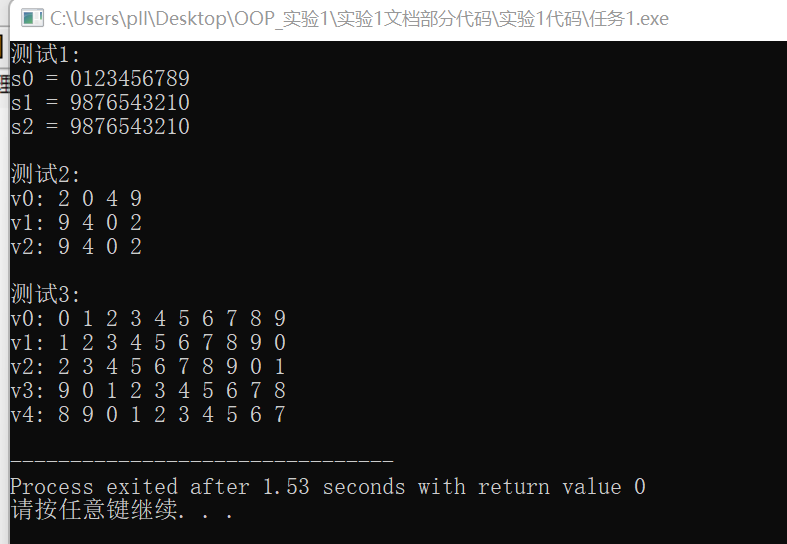
回答问题:
问题1: reverse 和 reverse_copy 有什么区别? 问题2: rotate 算法是如何改变元素顺序的?它的三个参数分别代表什么?
1.reverse和reverse_copy的区别在于reverse是直接反转原来元素的顺序,而reverse_copy相当于建立一个副本,在副本上反转原来的元素顺序,不修改原始数据。
2.rotate算法工作原理:rotate执行循环左移的操作,使得元素n_first成为新的第一个元素,n_first之前的元素移动到末尾。即:先将序列分成两部分[first,n_first)和[n_first,last)两部分,然后再交换两部分的位置。
三个参数的含义:first:范围起始位置;n_first:要旋转到起始位置的元素;last:范围结束位置
任务2:
源代码:

1 #include <iostream> 2 #include <vector> 3 #include <algorithm> 4 #include <numeric> 5 #include <iomanip> 6 #include <cstdlib> 7 #include <ctime> 8 template<typename T> 9 void output(const T &c); 10 11 int generate_random_number(); 12 void test1(); 13 void test2(); 14 15 int main() { 16 std::srand(std::time(0)); 17 std::cout << "测试1: \n"; 18 test1(); 19 20 std::cout << "\n测试2: \n"; 21 test2(); 22 } 23 24 template <typename T> 25 void output(const T &c) { 26 for(auto &i: c) 27 std::cout << i << ' '; 28 std::cout << '\n'; 29 } 30 31 int generate_random_number() { 32 return std::rand() % 101; 33 } 34 35 void test1() { 36 using namespace std; 37 38 vector<int> v0(10); 39 generate(v0.begin(), v0.end(), generate_random_number); 40 cout << "v0: "; output(v0); 41 42 vector<int> v1{v0}; 43 sort(v1.begin(), v1.end()); 44 cout << "v1: "; output(v1); 45 46 vector<int> v2{v0}; 47 sort(v2.begin()+1, v2.end()-1); 48 cout << "v2: "; output(v2); 49 } 50 51 52 void test2() { 53 using namespace std; 54 55 vector<int> v0(10); 56 generate(v0.begin(), v0.end(), generate_random_number); 57 cout << "v0: "; output(v0); 58 auto min_iter = min_element(v0.begin(), v0.end()); 59 auto max_iter = max_element(v0.begin(), v0.end()); 60 cout << "最小值: " << *min_iter << endl; 61 cout << "最大值: " << *max_iter << endl; 62 auto ans = minmax_element(v0.begin(), v0.end()); 63 cout << "最小值: " << *(ans.first) << endl; 64 cout << "最大值: " << *(ans.second) << endl; 65 double avg1 = accumulate(v0.begin(), v0.end(), 0.0) / v0.size(); 66 cout << "均值: " << fixed << setprecision(2) << avg1 << endl; 67 sort(v0.begin(), v0.end()); 68 double avg2 = accumulate(v0.begin()+1, v0.end()-1, 0.0) / (v0.size()-2); 69 cout << "去掉最大值、最小值之后,均值: " << avg2 << endl; 70 }
运行结果截图:
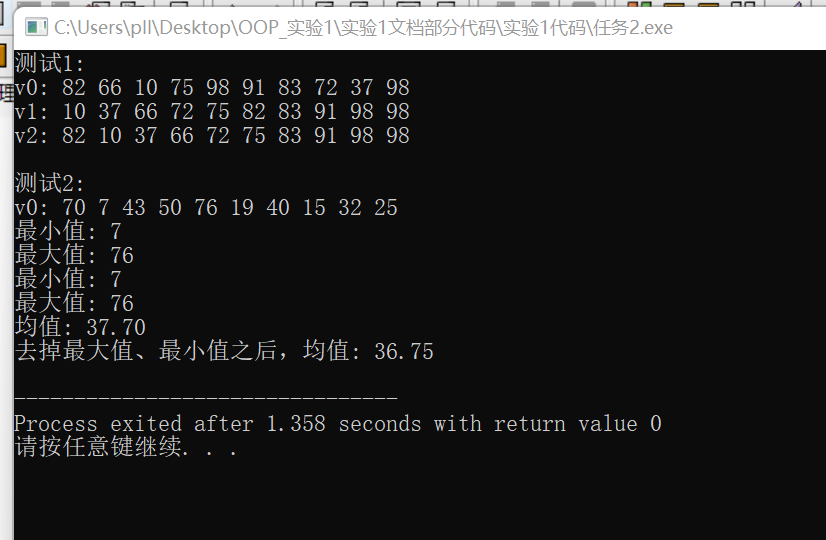
回答问题:
问题1: generate 算法的作用是什么? 问题2: minmax_element 和分别调用 min_element 、 max_element 相比,有什么优势? 问题3:把代码中函数 generate_random_number 的声明(line13)和定义(line35-37)注释起来,把两处调用改成如下写法,观察效果是否等同?lambda表达式适用场景是什么?
1.general算法的作用是将给定的函数对象所生成的值赋值给范围[first,last)中的每个元素,该任务代码中使用generate_random_number函数生成的随机数填充v0中的每个元素。
2.优势在于minmax element只需要遍历一次,时间复杂度更低,而且一行代码即可完成。
3.效果相同,都会用0-100的随机数填充容器;lambda的适用场景有替代简单的函数对象、简化测试代码、函数逻辑较为简单时可用。
任务3:
源代码:

1 #include <iostream> 2 #include <string> 3 #include <algorithm> 4 #include <cctype> 5 6 unsigned char func(unsigned char c); 7 void test1(); 8 void test2(); 9 10 int main() { 11 std::cout << "测试1: 字符串大小写转换\n"; 12 test1(); 13 14 std::cout << "\n测试2: 字符变换\n"; 15 test2(); 16 } 17 18 unsigned char func(unsigned char c) { 19 if(c == 'z') 20 return 'a'; 21 22 if(c == 'Z') 23 return 'A'; 24 25 if(std::isalpha(c)) 26 return static_cast<unsigned char>(c+1); 27 28 return c; 29 } 30 31 void test1() { 32 std::string s1{"Hello World 2049!"}; 33 std::cout << "s1 = " << s1 << '\n'; 34 35 std::string s2; 36 for(auto c: s1) 37 s2 += std::tolower(c); 38 std::cout << "s2 = " << s2 << '\n'; 39 40 std::string s3; 41 for(auto c: s1) 42 s3 += std::toupper(c); 43 std::cout << "s3 = " << s3 << '\n'; 44 } 45 46 void test2() { 47 std::string s1{"I love cosmos!"}; 48 std::cout << "s1 = " << s1 << '\n'; 49 50 std::string s2(s1.size(), ' '); 51 std::transform(s1.begin(), s1.end(), 52 s2.begin(), 53 func); 54 std::cout << "s2 = " << s2 << '\n'; 55 }
运行结果截图:
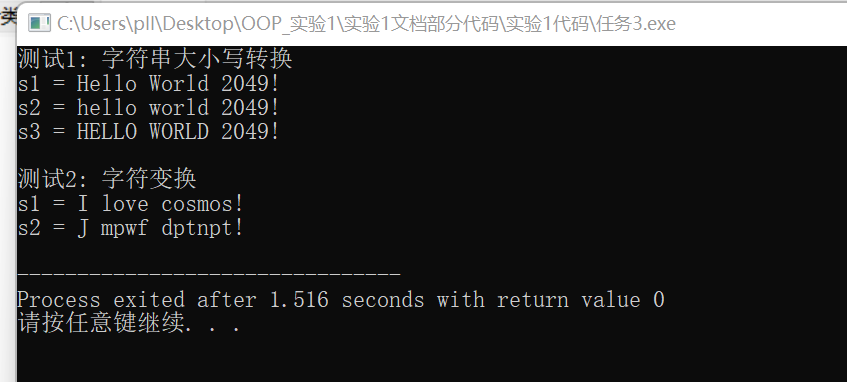
回答问题:
问题1:自定义函数 func 功能是什么? 问题2: tolower 和 toupper 功能分别是什么? 问题3: transform 的4个参数意义分别是什么?如果把第3个参数 s2.begin() 改成 s1.begin() ,有何区别?
1.func函数的功能是字母表循环后向下一个字母移动,可以将每个字母替换成字母表中的下一个字母。
2.tolower的功能是将字符转换为小写形式;toupper的功能是将字符转换为大写形式。
3.四个参数的意义:first1:输入范围的开始值
last1:输入范围的结束值
d_first:输出范围的开始值
unary_op:操作函数
区别在于:如果使用s2.begin():不是在原基础上操作,原始数据仍被保留,而s1.begin()在原基础上操作,会修改原始数据
任务4:
源代码:

1 #include <iostream> 2 #include <string> 3 #include <algorithm> 4 5 bool is_palindrome(const std::string &s); 6 bool is_palindrome_ignore_case(const std::string &s); 7 8 int main() { 9 using namespace std; 10 string s; 11 while(cin >> s) { 12 cout << boolalpha 13 << "区分大小写: " << is_palindrome(s) << "\n" 14 << "不区分大小写: " << is_palindrome_ignore_case(s) << "\n\n"; 15 } 16 } 17 18 bool is_palindrome(const std::string &s) { 19 int left = 0; 20 int right = s.length() - 1; 21 22 while (left < right) { 23 if (s[left] != s[right]) { 24 return false; 25 } 26 left++; 27 right--; 28 } 29 return true; 30 } 31 32 bool is_palindrome_ignore_case(const std::string &s) { 33 int left = 0; 34 int right = s.length() - 1; 35 36 while (left < right) { 37 if (std::tolower(s[left]) != std::tolower(s[right])) { 38 return false; 39 } 40 left++; 41 right--; 42 } 43 return true; 44 }
运行结果截图:
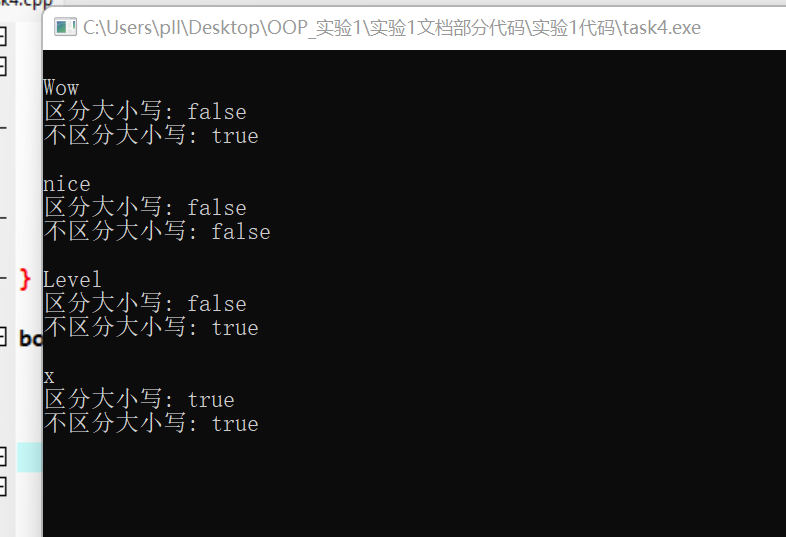
回答问题:
问题:使用 cin >> s 输入时,输入的字符串中不能包含空格。如果希望测试字符串包含空格(如 hello oop ),代码应如何调整?
如果要测试包含空格的字符串,可以使用 std::getline(cin, s) 代替 cin >> s:
任务5:
源代码:

1 #include <iostream> 2 #include <string> 3 #include <algorithm> 4 5 std::string dec2n(int x, int n = 2); 6 7 int main() { 8 int x; 9 while(std::cin >> x) { 10 std::cout << "十进制: " << x << '\n' 11 << "二进制: " << dec2n(x) << '\n' 12 << "八进制: " << dec2n(x, 8) << '\n' 13 << "十二进制: " << dec2n(x, 12) << '\n' 14 << "十六进制: " << dec2n(x, 16) << '\n' 15 << "三十二进制: " << dec2n(x, 32) << "\n\n"; 16 } 17 } 18 19 std::string dec2n(int x, int n) { 20 if (x == 0) { 21 return "0"; 22 } 23 if (n < 2 || n > 36) { 24 return "Error"; 25 } 26 std::string result = ""; 27 int num = x; 28 while (num > 0) { 29 int remainder = num % n; 30 num = num / n; 31 if (remainder < 10) { 32 result += '0' + remainder; 33 } else { 34 result += 'A' + (remainder - 10); 35 } 36 } 37 std::reverse(result.begin(), result.end()); 38 39 return result; 40 }
运行结果截图:
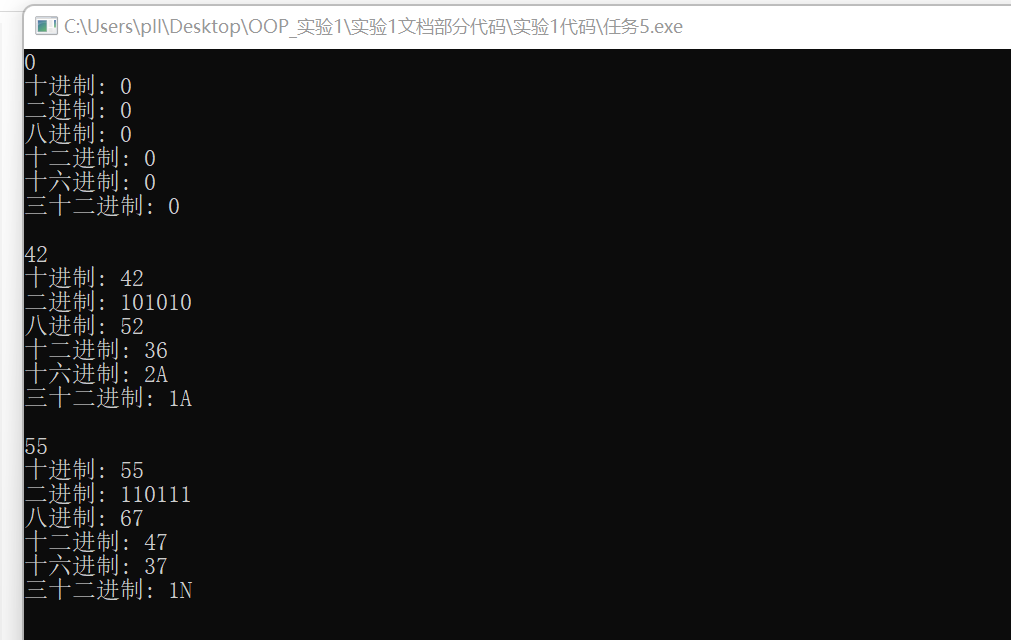
任务6:
源代码:

1 #include <iostream> 2 #include <string> 3 #include <algorithm> 4 #include <cctype> 5 using namespace std; 6 void test1(); // 打印原始字母表 7 void test2(); // 打印移位字母表 8 string shiftAlphabet(const std::string& alphabet, int shift); 9 10 int main() { 11 cout << "字母密文对照表:\n\n"; 12 13 test1(); 14 test2(); 15 16 return 0; 17 } 18 19 void test1() { 20 string alphabet = "abcdefghijklmnopqrstuvwxyz"; 21 cout << alphabet << endl; 22 } 23 24 void test2() { 25 string alphabet = "abcdefghijklmnopqrstuvwxyz"; 26 27 for (int i = 1; i <= 26; ++i) { 28 string shifted = alphabet; 29 rotate(shifted.begin(), shifted.begin() + i, shifted.end()); 30 transform(shifted.begin(), shifted.end(), shifted.begin(), ::toupper); 31 32 cout << i << shifted << endl; 33 } 34 }
运行结果截图:
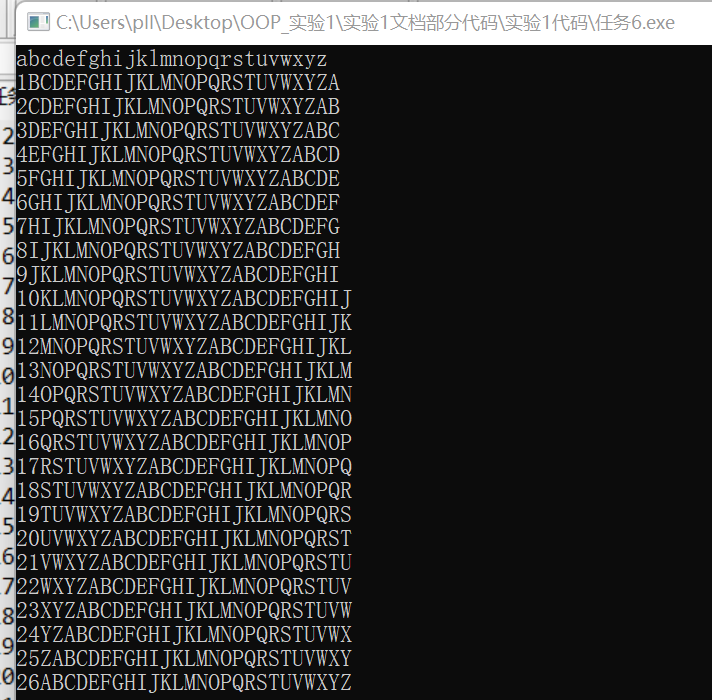
任务7:
源代码:

1 #include <iostream> 2 #include <cstdlib> 3 #include <ctime> 4 #include <iomanip> 5 #include <string> 6 using namespace std; 7 int main() { 8 srand(time(0)); 9 int correctCount = 0; 10 for (int i = 0; i < 10; ++i) { 11 int num1 = rand() % 10 + 1; 12 int num2 = rand() % 10 + 1; 13 int a = rand() % 4; 14 char operator_a; 15 int correctAnswer; 16 switch (a) { 17 case 0: 18 operator_a = '+'; 19 correctAnswer = num1 + num2; 20 break; 21 22 case 1: 23 if (num1 < num2) { 24 swap(num1, num2); 25 } 26 operator_a = '-'; 27 correctAnswer = num1 - num2; 28 break; 29 30 case 2: 31 operator_a = '*'; 32 correctAnswer = num1 * num2; 33 break; 34 35 case 3: 36 if (num1 < num2) { 37 swap(num1, num2); 38 } 39 if (num2 > 1) { 40 int maxMultiple = 10 / num2; 41 if (maxMultiple > 0) { 42 num1 = num2 * (rand() % maxMultiple + 1); 43 } else { 44 num1 = num2; 45 } 46 } 47 operator_a = '/'; 48 correctAnswer = num1 / num2; 49 break; 50 } 51 52 cout << num1 << " " << operator_a << " " << num2 << " = "; 53 int userAnswer; 54 cin >> userAnswer; 55 56 if (userAnswer == correctAnswer) { 57 correctCount++; 58 } 59 } 60 61 double accuracy = (static_cast<double>(correctCount) / 10) * 100; 62 cout << "\n正确率:" << fixed << setprecision(2) << accuracy << "%" << endl; 63 64 return 0; 65 }
运行结果截图:
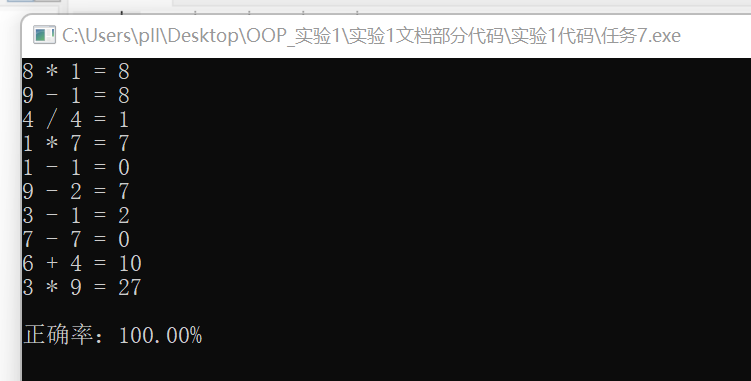
实验总结:
1收获: 1)学会了使用迭代器进行容器遍历和算法操作
2)新学习到了tolower的功能是将字符转换为小写形式;toupper的功能是将字符转换为大写形式。
3) 新学习到了general的算法:作用是将给定的函数对象所生成的值赋值给范围[first,last)中的每个元素,该任务代码中使用generate_random_number函数生成的随机数填充v0中的每个元素。
2.我的感受:1)成就感:从最初对C++的陌生到能够效仿前几个任务完成回文判断、进制转换等任务的代码书写,让我体会到了亲手敲代码比复制粘贴更能加深理解,而且在调试过程中发现的错误也能及时帮助巩固一些知识点。
2) 挑战性:理解算法原理和模板机制时需要花费大量时间反复思考和实验

